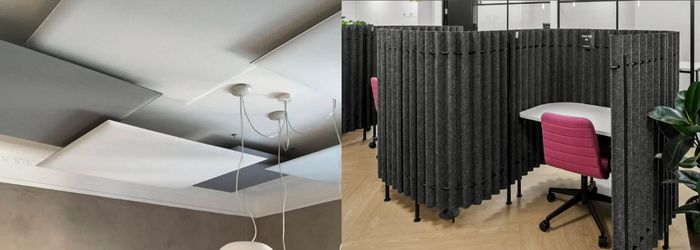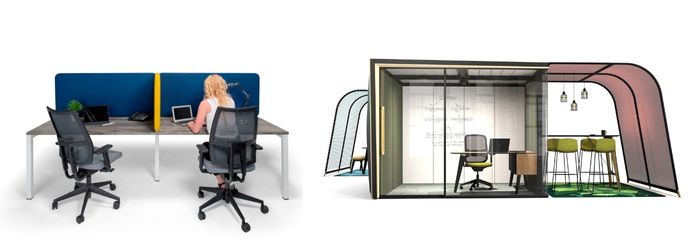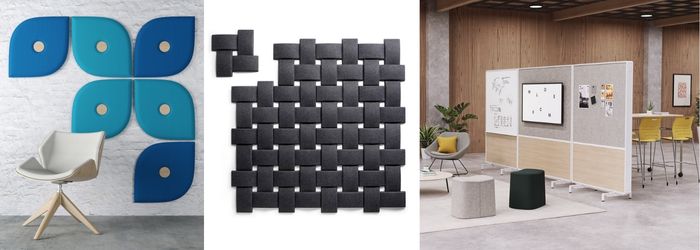Have you ever thought about the acoustics in your office? The workplace can often be a chaotic environment of jarring sounds that become an issue for people’s ability to concentrate. Some people prefer noise and some people prefer quiet, but either way, a lot of constant noise can be distracting to everyone.
Relaxed office spaces and open-plan configurations with fewer private offices and more collaborative areas are great for a creative work culture. But open-plan spaces can also create more noise and be distracting, irritating and less productive. As we move back to the workplace from the quiet of our home office environment, employees may be more sensitive to noise and distractions than usual so it’s worth considering the value of adding acoustic products to your workspace.

Why are acoustics important?
Designing workspaces to enhance the employee experience is important for health and wellbeing. Excessive noise can cause listening fatigue which increases tiredness as your brain works hard to identify different sounds and filter out the noise you do or do not want to hear. Background noise is also a distraction, which can inadvertently increase stress levels.
Experiments show that a mid-level noise can be the best for creativity but it’s important to remember that everyone has different noise levels that they can cope with. Workplaces need to ensure they can cater for neurodiverse employees who may suffer from sensory stress issues due to sound.
You can check the Government guidance on safe noise levels in an office here.

Where does the noise come from and what is it?
Usually, several different noise sources can be affecting your workplace, particularly in open-plan spaces. People talking, machines such as the photocopier or air conditioner, phones ringing, meetings, background music, chatter in the kitchen area and voices or footsteps travelling through from different areas.
These noises along with other factors can cause poor acoustics in the workplace. A multitude of hard surfaces including walls, floors, wide open ceilings, windows, desks and other furniture all contribute to echo and reverberation.
Identifying the source of the problem is the first step in finding the right solution for your space.

Acoustic solutions
Acoustic products help to reduce noise by absorbing and dissipating sound waves. The good news is that you don’t need to completely refit your office to integrate an acoustic solution. We have listed some examples below:
Ceilings
Ceiling panels are an effective way of reducing reverberation. Ocee design offers a multitude of solutions using ‘sound-absorbing Snowsound® technology’ including simple colourful tiles that can be easily swapped out with existing ceiling tiles or their Oversize panels that give full coverage with a sleek design.
Walls
Wall acoustic solutions are a great way to bring colour and visually striking design to your workspace. Don’t be afraid to make bold choices when choosing panels and think of them as art installations.
The Hush wall-mounted panels from Elite are available in multiple colour ways and can be used to create flexible and changeable designs. Or consider the modern Soundwave® collection from Offect to create numerous unique designs to suit your space.
Floors
Rugs and carpet can provide good sound dampening qualities for hard floors. Or try FlexForm Sound™ LVT from flooring specialists Miliken. A compact cushioned layer which reduces sound levels by up to 17dB.
Adding acoustics to the floor is definitely something to consider if your space suffers from sound travelling between floors. It’s also an ideal solution in video conferencing and meeting rooms to help prevent reverberation.
Desk Screens
Desk screens help to reduce the noise of typing and conversations between workstations. They are particularly useful in an office where everyone is on the phone such as busy contact centres.
These screens from Era are made with sound-absorbing foam and a range of fabrics. The timeless design makes them suited to most spaces.
Floor Screens
The Diffuse collection from Allsfar is a collection of curved screens that can be arranged in multiple iterations to create completely flexible configurations with acoustic privacy. They can also be used as wall or ceiling panels.
Room dividers
The popular design Airflake from Abstracta works as a suspended screen that can be used to break up open-plan spaces, providing a sense of privacy whilst also helping to reduce sound levels and echo. Available in multiple colour options to complement your space.
Panels
Another way to reduce the amount of noise in an office is to create designated spaces for activities such as brainstorming sessions or team meetings. We recommend multi-use portable partitions with fabric panels such as the Adapt range from Senator that can be moved around as needed.
Plants and Living walls
Plants have great sound-absorbing properties and are a quick and easy addition to your office. Choose different sizes for even more variation but preferably stick to ones that do well in low-light conditions.
Or for a real show stopper try a living wall or the Para Vert modular plant screen from Brunner.
Furniture
To reduce the number of hard surfaces in the office, ensure you add soft furnishings to your seating choices to help absorb sound.
Acoustic specialists Buzzispace have a collection of furniture specifically made with layers of sound-absorbing foam and fabric to help reduce echo.
Pods
Pods are often used more specifically for soundproofing than acoustics to create complete sound privacy in an open-plan space.
This pod from Framery has been confirmed to reduce speech levels by 30dB meaning private conversations remain private. Or try the popular Campers and Dens collection from Orangebox which combine soundproofed pods and acoustic screens to create a completely unique design that fits in with your specific needs.

Getting the acoustics right for your space
Not all acoustic solutions will work for every space. To find the right solution for you start by identifying what your acoustic problem is. For example, are there background noise or privacy issues? Also think about which teams may benefit from a quieter space.
It is not only the number of people that can contribute to noise pollution in an office; it is also the type of activity being performed. Consider the type of work that is done in your office; which teams collaborate more vocally? Does anyone require absolute privacy and need a soundproofed area such as the HR team or company Director? People working from home will also benefit from good acoustics in your office when they join in video conference calls.
Optimizing the acoustics in your workspace can boost productivity and reduce risks to health. It’s a good idea to have an accessible quiet area where people can go when they need to talk on the phone or want a quiet space where they can focus. Remember, having good acoustics is not about creating a silent office but reducing the reverberation and echo of excessive noise to help prevent fatigue and stress.



